Critical Thinking and Academic Style: ENG 1110 Medieval Essay
VerifiedAdded on 2023/03/31
|8
|1601
|329
Essay
AI Summary
This essay, written in a medieval academic style, addresses the question of whether critical thinking can be taught. The author presents a thesis question and argues in the affirmative, supporting the position with multiple sources, including philosophers and researchers. The essay follows the prescribed structure, including three objections to the central argument, followed by a contrary statement and an answer that presents the author's argument in several paragraphs. The author then provides replies to each of the initial objections, engaging with opposing viewpoints. The essay explores concepts like deductive and inductive reasoning, the role of logic, and the impact of knowledge on critical thought. The author cites sources such as Doyle, Plato, and contemporary academics to support claims and analyzes the interplay of critical thinking with literacy and learning processes, concluding that critical thinking is not just common sense but a skill developed through open-mindedness, a process of continuous learning and applying common sense to weigh ideas from different perspectives.
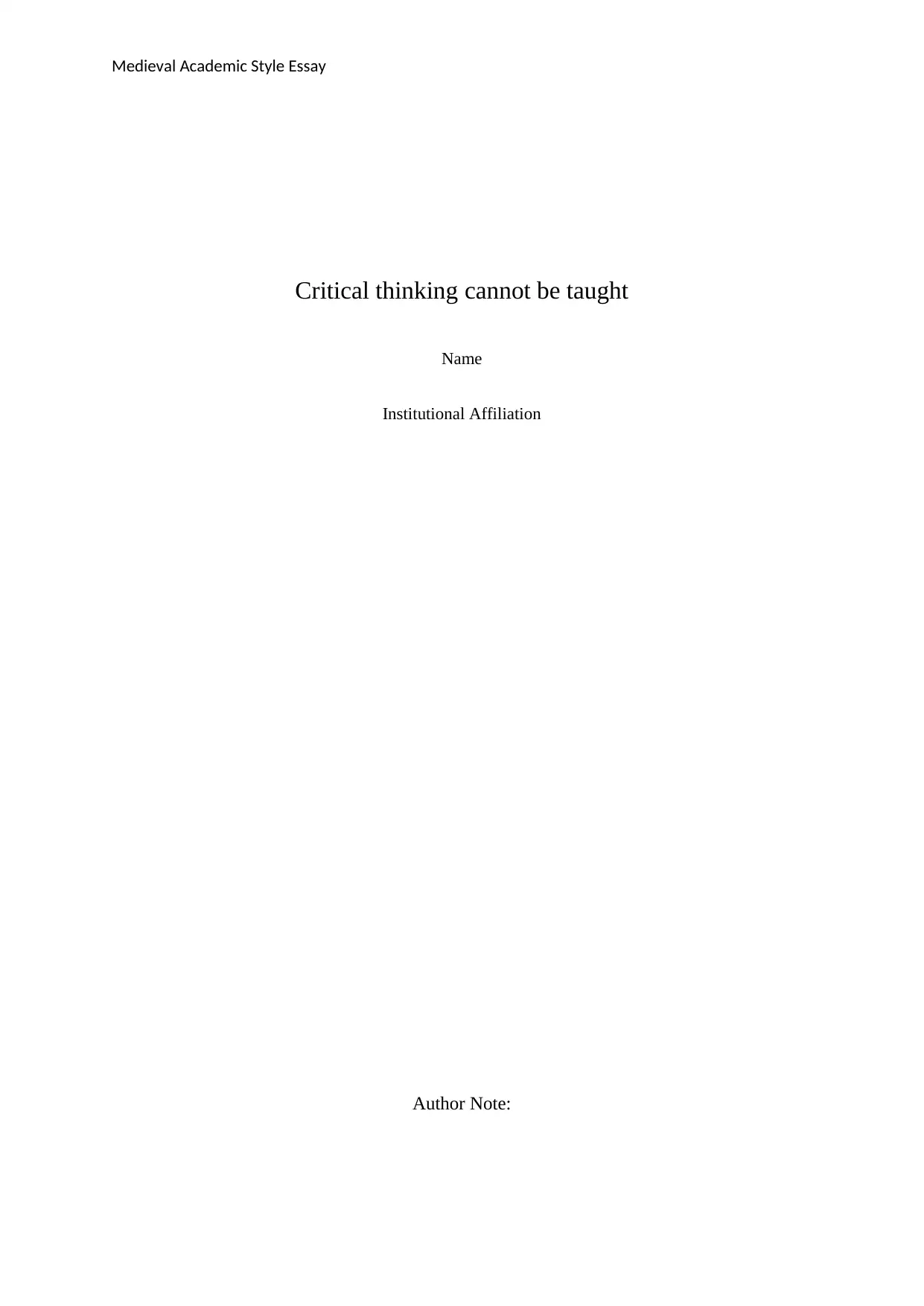
Medieval Academic Style Essay
Critical thinking cannot be taught
Name
Institutional Affiliation
Author Note:
Critical thinking cannot be taught
Name
Institutional Affiliation
Author Note:
Paraphrase This Document
Need a fresh take? Get an instant paraphrase of this document with our AI Paraphraser
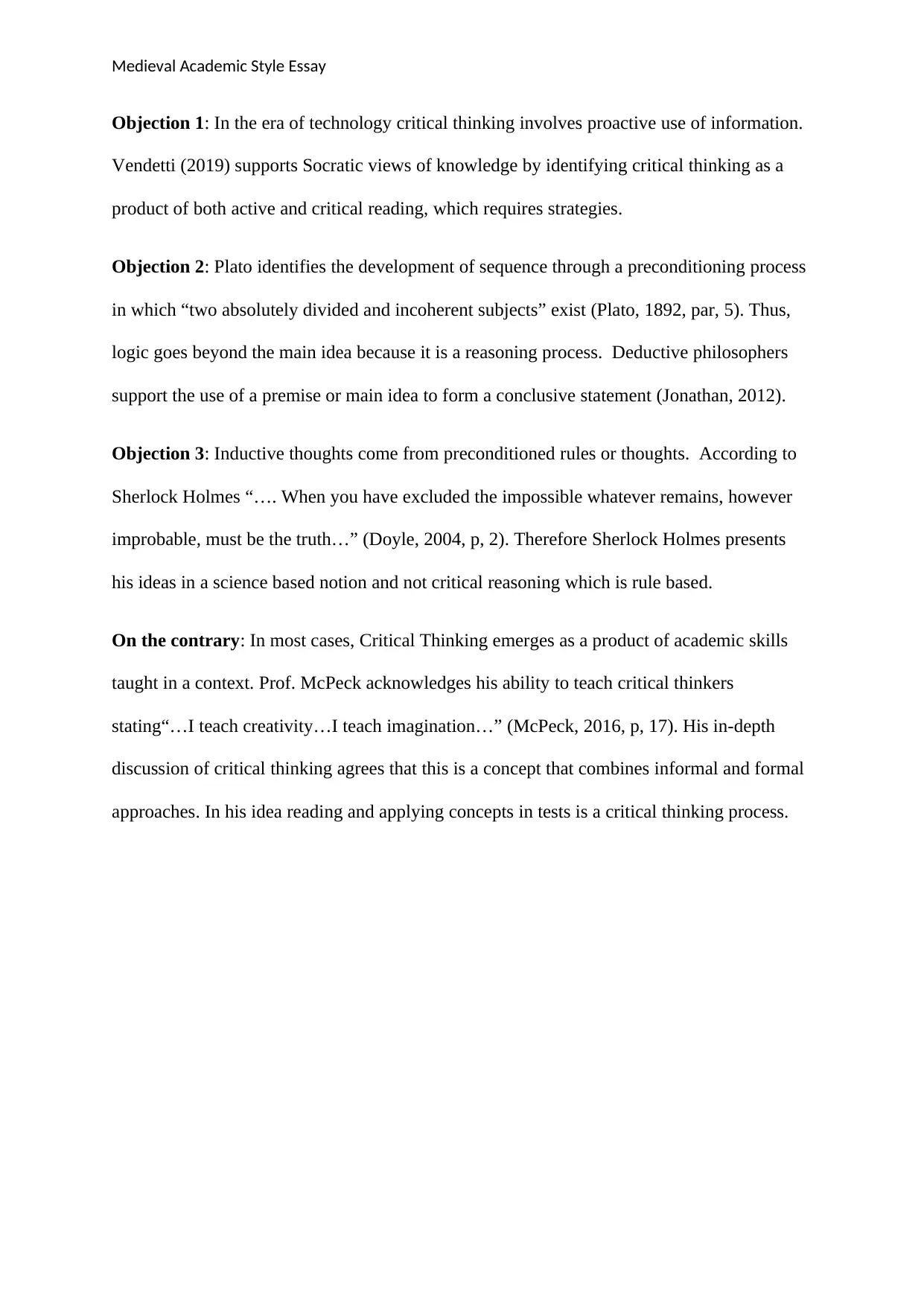
Medieval Academic Style Essay
Objection 1: In the era of technology critical thinking involves proactive use of information.
Vendetti (2019) supports Socratic views of knowledge by identifying critical thinking as a
product of both active and critical reading, which requires strategies.
Objection 2: Plato identifies the development of sequence through a preconditioning process
in which “two absolutely divided and incoherent subjects” exist (Plato, 1892, par, 5). Thus,
logic goes beyond the main idea because it is a reasoning process. Deductive philosophers
support the use of a premise or main idea to form a conclusive statement (Jonathan, 2012).
Objection 3: Inductive thoughts come from preconditioned rules or thoughts. According to
Sherlock Holmes “…. When you have excluded the impossible whatever remains, however
improbable, must be the truth…” (Doyle, 2004, p, 2). Therefore Sherlock Holmes presents
his ideas in a science based notion and not critical reasoning which is rule based.
On the contrary: In most cases, Critical Thinking emerges as a product of academic skills
taught in a context. Prof. McPeck acknowledges his ability to teach critical thinkers
stating“…I teach creativity…I teach imagination…” (McPeck, 2016, p, 17). His in-depth
discussion of critical thinking agrees that this is a concept that combines informal and formal
approaches. In his idea reading and applying concepts in tests is a critical thinking process.
Objection 1: In the era of technology critical thinking involves proactive use of information.
Vendetti (2019) supports Socratic views of knowledge by identifying critical thinking as a
product of both active and critical reading, which requires strategies.
Objection 2: Plato identifies the development of sequence through a preconditioning process
in which “two absolutely divided and incoherent subjects” exist (Plato, 1892, par, 5). Thus,
logic goes beyond the main idea because it is a reasoning process. Deductive philosophers
support the use of a premise or main idea to form a conclusive statement (Jonathan, 2012).
Objection 3: Inductive thoughts come from preconditioned rules or thoughts. According to
Sherlock Holmes “…. When you have excluded the impossible whatever remains, however
improbable, must be the truth…” (Doyle, 2004, p, 2). Therefore Sherlock Holmes presents
his ideas in a science based notion and not critical reasoning which is rule based.
On the contrary: In most cases, Critical Thinking emerges as a product of academic skills
taught in a context. Prof. McPeck acknowledges his ability to teach critical thinkers
stating“…I teach creativity…I teach imagination…” (McPeck, 2016, p, 17). His in-depth
discussion of critical thinking agrees that this is a concept that combines informal and formal
approaches. In his idea reading and applying concepts in tests is a critical thinking process.
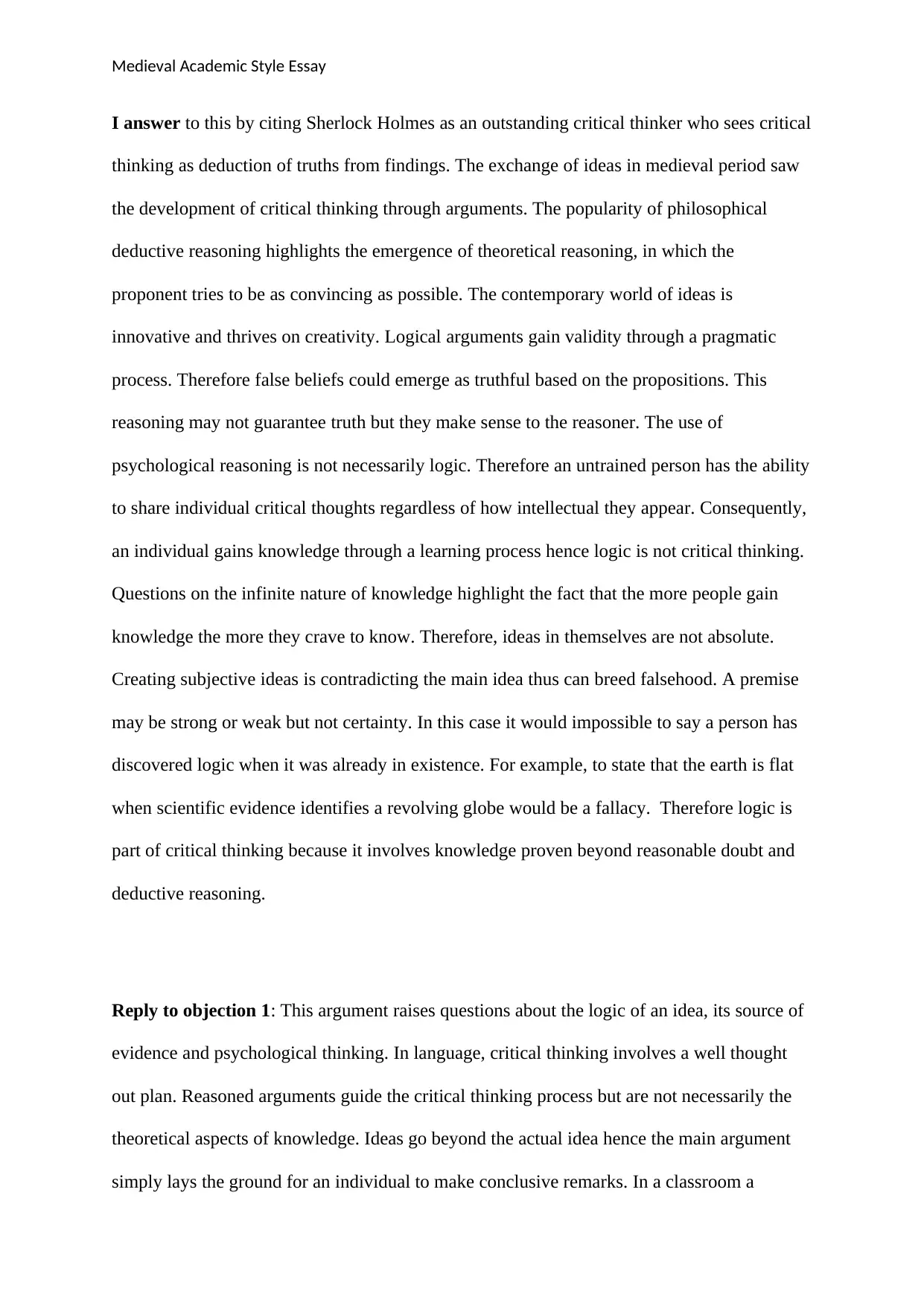
Medieval Academic Style Essay
I answer to this by citing Sherlock Holmes as an outstanding critical thinker who sees critical
thinking as deduction of truths from findings. The exchange of ideas in medieval period saw
the development of critical thinking through arguments. The popularity of philosophical
deductive reasoning highlights the emergence of theoretical reasoning, in which the
proponent tries to be as convincing as possible. The contemporary world of ideas is
innovative and thrives on creativity. Logical arguments gain validity through a pragmatic
process. Therefore false beliefs could emerge as truthful based on the propositions. This
reasoning may not guarantee truth but they make sense to the reasoner. The use of
psychological reasoning is not necessarily logic. Therefore an untrained person has the ability
to share individual critical thoughts regardless of how intellectual they appear. Consequently,
an individual gains knowledge through a learning process hence logic is not critical thinking.
Questions on the infinite nature of knowledge highlight the fact that the more people gain
knowledge the more they crave to know. Therefore, ideas in themselves are not absolute.
Creating subjective ideas is contradicting the main idea thus can breed falsehood. A premise
may be strong or weak but not certainty. In this case it would impossible to say a person has
discovered logic when it was already in existence. For example, to state that the earth is flat
when scientific evidence identifies a revolving globe would be a fallacy. Therefore logic is
part of critical thinking because it involves knowledge proven beyond reasonable doubt and
deductive reasoning.
Reply to objection 1: This argument raises questions about the logic of an idea, its source of
evidence and psychological thinking. In language, critical thinking involves a well thought
out plan. Reasoned arguments guide the critical thinking process but are not necessarily the
theoretical aspects of knowledge. Ideas go beyond the actual idea hence the main argument
simply lays the ground for an individual to make conclusive remarks. In a classroom a
I answer to this by citing Sherlock Holmes as an outstanding critical thinker who sees critical
thinking as deduction of truths from findings. The exchange of ideas in medieval period saw
the development of critical thinking through arguments. The popularity of philosophical
deductive reasoning highlights the emergence of theoretical reasoning, in which the
proponent tries to be as convincing as possible. The contemporary world of ideas is
innovative and thrives on creativity. Logical arguments gain validity through a pragmatic
process. Therefore false beliefs could emerge as truthful based on the propositions. This
reasoning may not guarantee truth but they make sense to the reasoner. The use of
psychological reasoning is not necessarily logic. Therefore an untrained person has the ability
to share individual critical thoughts regardless of how intellectual they appear. Consequently,
an individual gains knowledge through a learning process hence logic is not critical thinking.
Questions on the infinite nature of knowledge highlight the fact that the more people gain
knowledge the more they crave to know. Therefore, ideas in themselves are not absolute.
Creating subjective ideas is contradicting the main idea thus can breed falsehood. A premise
may be strong or weak but not certainty. In this case it would impossible to say a person has
discovered logic when it was already in existence. For example, to state that the earth is flat
when scientific evidence identifies a revolving globe would be a fallacy. Therefore logic is
part of critical thinking because it involves knowledge proven beyond reasonable doubt and
deductive reasoning.
Reply to objection 1: This argument raises questions about the logic of an idea, its source of
evidence and psychological thinking. In language, critical thinking involves a well thought
out plan. Reasoned arguments guide the critical thinking process but are not necessarily the
theoretical aspects of knowledge. Ideas go beyond the actual idea hence the main argument
simply lays the ground for an individual to make conclusive remarks. In a classroom a
⊘ This is a preview!⊘
Do you want full access?
Subscribe today to unlock all pages.

Trusted by 1+ million students worldwide
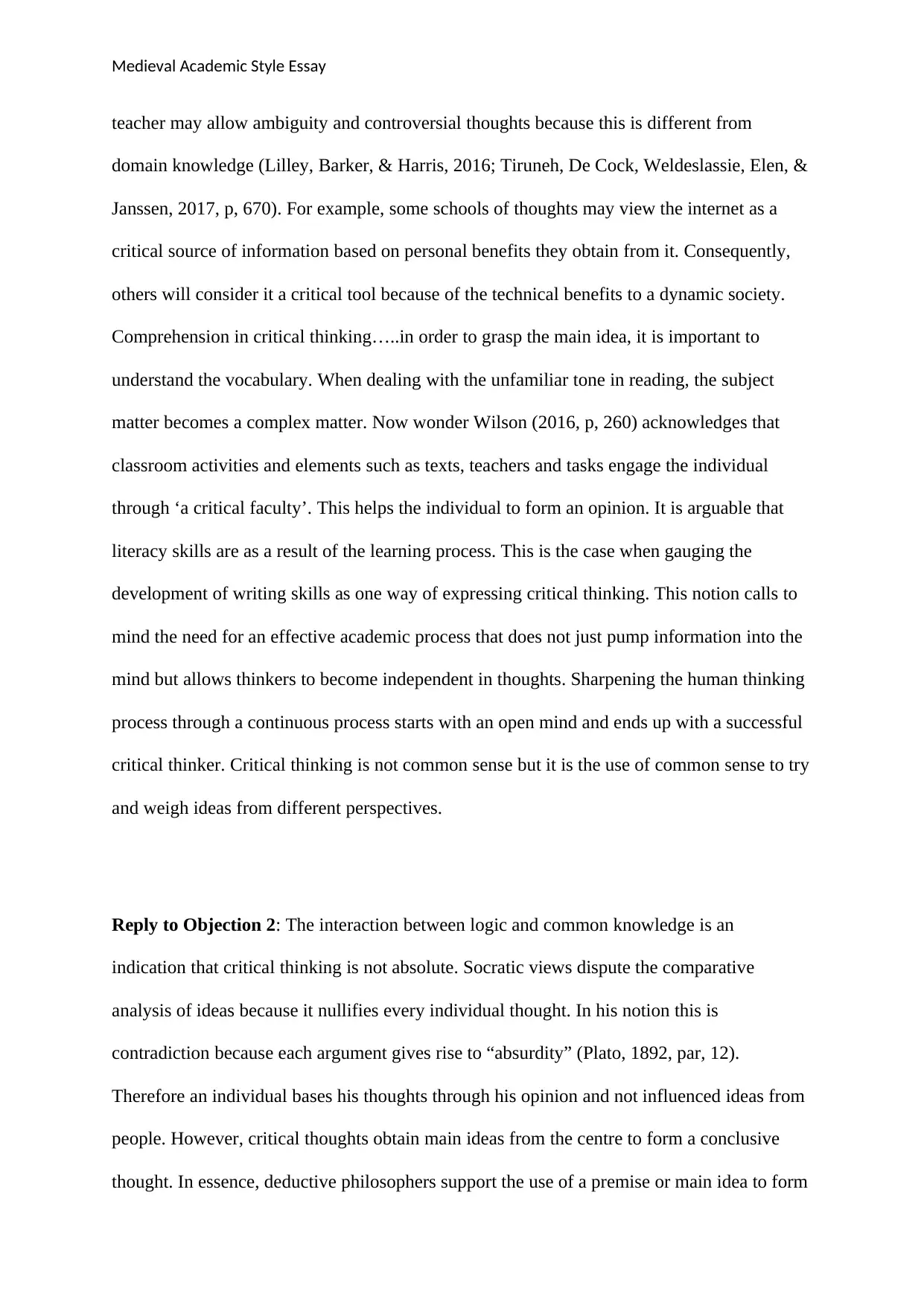
Medieval Academic Style Essay
teacher may allow ambiguity and controversial thoughts because this is different from
domain knowledge (Lilley, Barker, & Harris, 2016; Tiruneh, De Cock, Weldeslassie, Elen, &
Janssen, 2017, p, 670). For example, some schools of thoughts may view the internet as a
critical source of information based on personal benefits they obtain from it. Consequently,
others will consider it a critical tool because of the technical benefits to a dynamic society.
Comprehension in critical thinking…..in order to grasp the main idea, it is important to
understand the vocabulary. When dealing with the unfamiliar tone in reading, the subject
matter becomes a complex matter. Now wonder Wilson (2016, p, 260) acknowledges that
classroom activities and elements such as texts, teachers and tasks engage the individual
through ‘a critical faculty’. This helps the individual to form an opinion. It is arguable that
literacy skills are as a result of the learning process. This is the case when gauging the
development of writing skills as one way of expressing critical thinking. This notion calls to
mind the need for an effective academic process that does not just pump information into the
mind but allows thinkers to become independent in thoughts. Sharpening the human thinking
process through a continuous process starts with an open mind and ends up with a successful
critical thinker. Critical thinking is not common sense but it is the use of common sense to try
and weigh ideas from different perspectives.
Reply to Objection 2: The interaction between logic and common knowledge is an
indication that critical thinking is not absolute. Socratic views dispute the comparative
analysis of ideas because it nullifies every individual thought. In his notion this is
contradiction because each argument gives rise to “absurdity” (Plato, 1892, par, 12).
Therefore an individual bases his thoughts through his opinion and not influenced ideas from
people. However, critical thoughts obtain main ideas from the centre to form a conclusive
thought. In essence, deductive philosophers support the use of a premise or main idea to form
teacher may allow ambiguity and controversial thoughts because this is different from
domain knowledge (Lilley, Barker, & Harris, 2016; Tiruneh, De Cock, Weldeslassie, Elen, &
Janssen, 2017, p, 670). For example, some schools of thoughts may view the internet as a
critical source of information based on personal benefits they obtain from it. Consequently,
others will consider it a critical tool because of the technical benefits to a dynamic society.
Comprehension in critical thinking…..in order to grasp the main idea, it is important to
understand the vocabulary. When dealing with the unfamiliar tone in reading, the subject
matter becomes a complex matter. Now wonder Wilson (2016, p, 260) acknowledges that
classroom activities and elements such as texts, teachers and tasks engage the individual
through ‘a critical faculty’. This helps the individual to form an opinion. It is arguable that
literacy skills are as a result of the learning process. This is the case when gauging the
development of writing skills as one way of expressing critical thinking. This notion calls to
mind the need for an effective academic process that does not just pump information into the
mind but allows thinkers to become independent in thoughts. Sharpening the human thinking
process through a continuous process starts with an open mind and ends up with a successful
critical thinker. Critical thinking is not common sense but it is the use of common sense to try
and weigh ideas from different perspectives.
Reply to Objection 2: The interaction between logic and common knowledge is an
indication that critical thinking is not absolute. Socratic views dispute the comparative
analysis of ideas because it nullifies every individual thought. In his notion this is
contradiction because each argument gives rise to “absurdity” (Plato, 1892, par, 12).
Therefore an individual bases his thoughts through his opinion and not influenced ideas from
people. However, critical thoughts obtain main ideas from the centre to form a conclusive
thought. In essence, deductive philosophers support the use of a premise or main idea to form
Paraphrase This Document
Need a fresh take? Get an instant paraphrase of this document with our AI Paraphraser
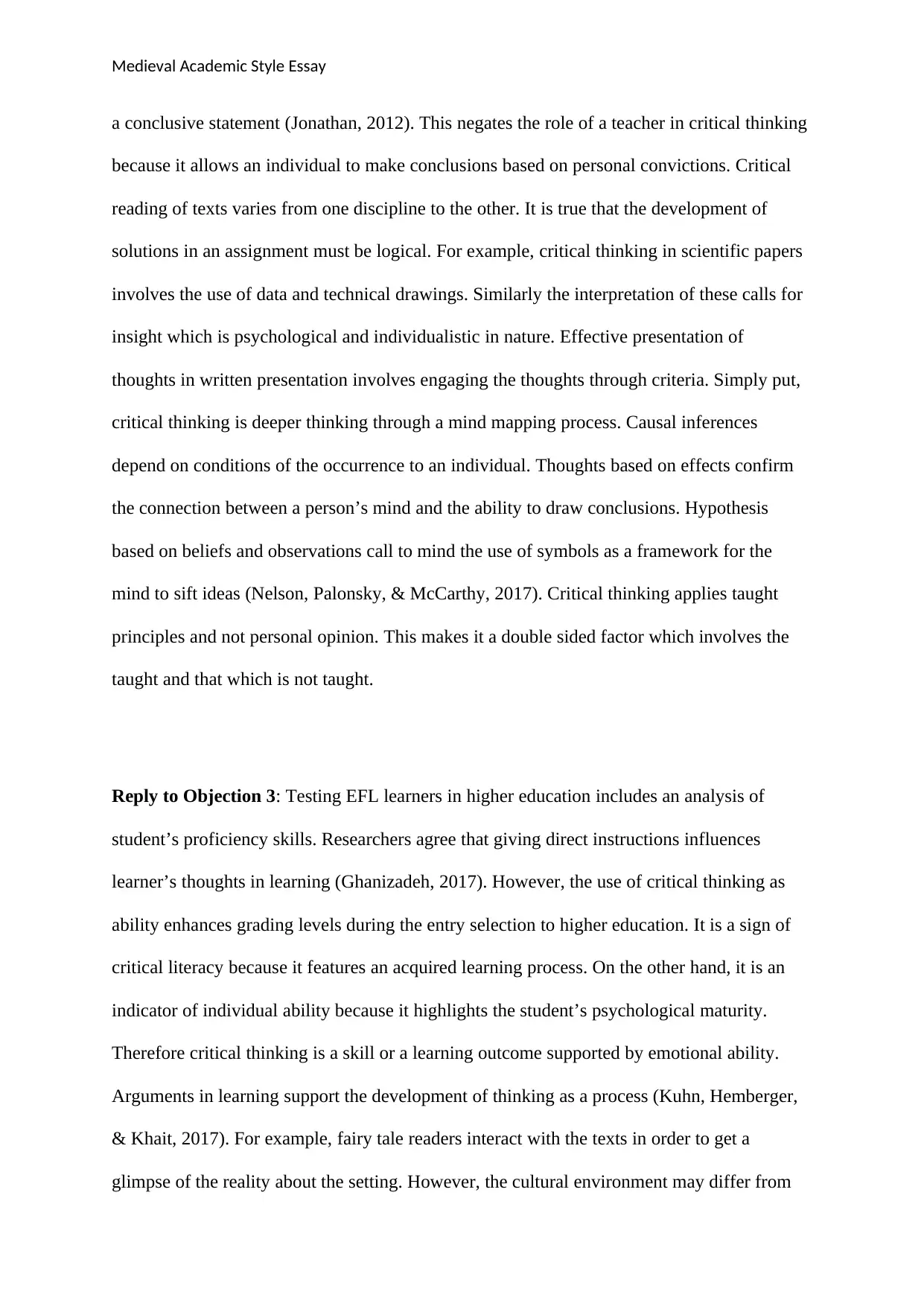
Medieval Academic Style Essay
a conclusive statement (Jonathan, 2012). This negates the role of a teacher in critical thinking
because it allows an individual to make conclusions based on personal convictions. Critical
reading of texts varies from one discipline to the other. It is true that the development of
solutions in an assignment must be logical. For example, critical thinking in scientific papers
involves the use of data and technical drawings. Similarly the interpretation of these calls for
insight which is psychological and individualistic in nature. Effective presentation of
thoughts in written presentation involves engaging the thoughts through criteria. Simply put,
critical thinking is deeper thinking through a mind mapping process. Causal inferences
depend on conditions of the occurrence to an individual. Thoughts based on effects confirm
the connection between a person’s mind and the ability to draw conclusions. Hypothesis
based on beliefs and observations call to mind the use of symbols as a framework for the
mind to sift ideas (Nelson, Palonsky, & McCarthy, 2017). Critical thinking applies taught
principles and not personal opinion. This makes it a double sided factor which involves the
taught and that which is not taught.
Reply to Objection 3: Testing EFL learners in higher education includes an analysis of
student’s proficiency skills. Researchers agree that giving direct instructions influences
learner’s thoughts in learning (Ghanizadeh, 2017). However, the use of critical thinking as
ability enhances grading levels during the entry selection to higher education. It is a sign of
critical literacy because it features an acquired learning process. On the other hand, it is an
indicator of individual ability because it highlights the student’s psychological maturity.
Therefore critical thinking is a skill or a learning outcome supported by emotional ability.
Arguments in learning support the development of thinking as a process (Kuhn, Hemberger,
& Khait, 2017). For example, fairy tale readers interact with the texts in order to get a
glimpse of the reality about the setting. However, the cultural environment may differ from
a conclusive statement (Jonathan, 2012). This negates the role of a teacher in critical thinking
because it allows an individual to make conclusions based on personal convictions. Critical
reading of texts varies from one discipline to the other. It is true that the development of
solutions in an assignment must be logical. For example, critical thinking in scientific papers
involves the use of data and technical drawings. Similarly the interpretation of these calls for
insight which is psychological and individualistic in nature. Effective presentation of
thoughts in written presentation involves engaging the thoughts through criteria. Simply put,
critical thinking is deeper thinking through a mind mapping process. Causal inferences
depend on conditions of the occurrence to an individual. Thoughts based on effects confirm
the connection between a person’s mind and the ability to draw conclusions. Hypothesis
based on beliefs and observations call to mind the use of symbols as a framework for the
mind to sift ideas (Nelson, Palonsky, & McCarthy, 2017). Critical thinking applies taught
principles and not personal opinion. This makes it a double sided factor which involves the
taught and that which is not taught.
Reply to Objection 3: Testing EFL learners in higher education includes an analysis of
student’s proficiency skills. Researchers agree that giving direct instructions influences
learner’s thoughts in learning (Ghanizadeh, 2017). However, the use of critical thinking as
ability enhances grading levels during the entry selection to higher education. It is a sign of
critical literacy because it features an acquired learning process. On the other hand, it is an
indicator of individual ability because it highlights the student’s psychological maturity.
Therefore critical thinking is a skill or a learning outcome supported by emotional ability.
Arguments in learning support the development of thinking as a process (Kuhn, Hemberger,
& Khait, 2017). For example, fairy tale readers interact with the texts in order to get a
glimpse of the reality about the setting. However, the cultural environment may differ from
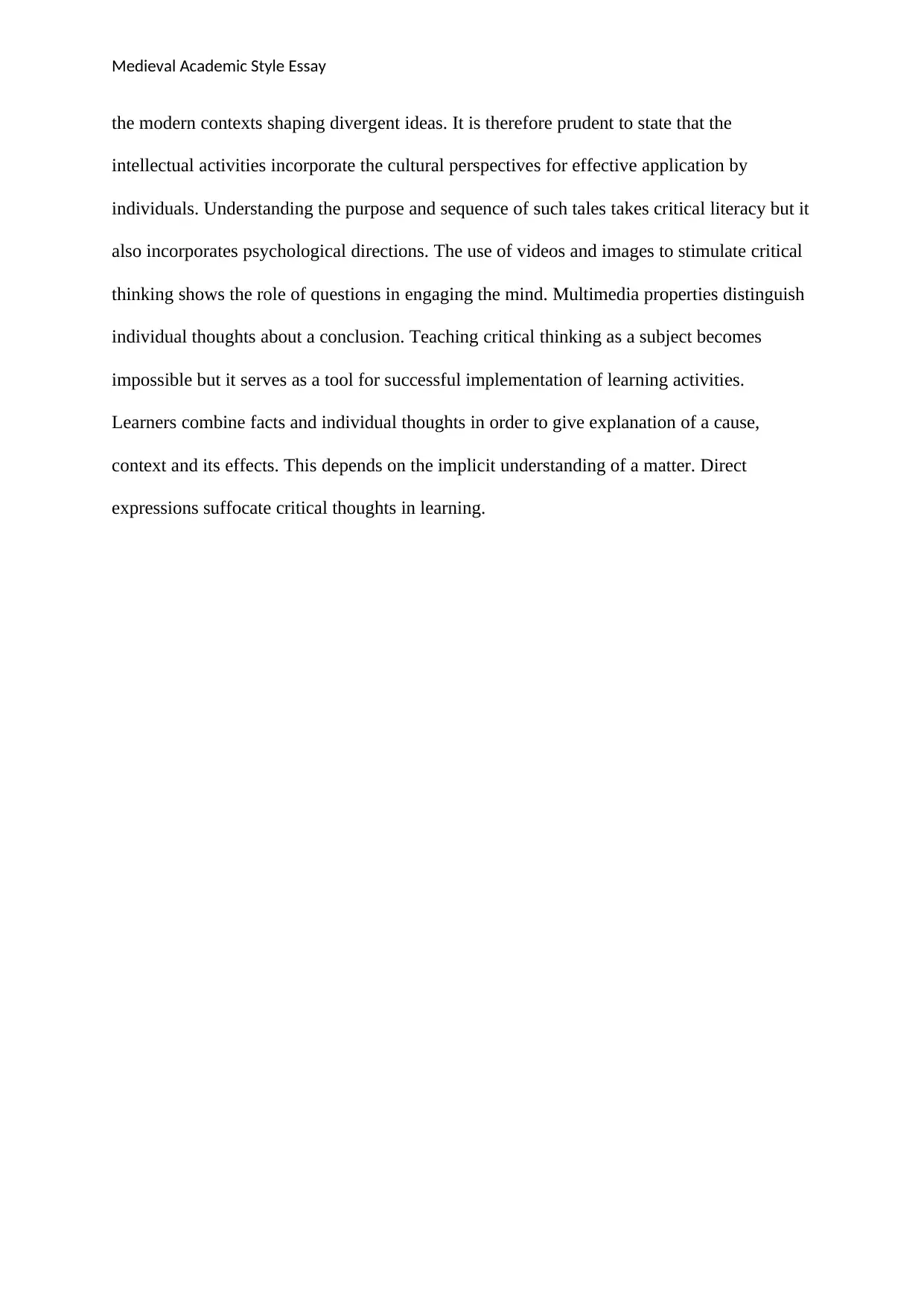
Medieval Academic Style Essay
the modern contexts shaping divergent ideas. It is therefore prudent to state that the
intellectual activities incorporate the cultural perspectives for effective application by
individuals. Understanding the purpose and sequence of such tales takes critical literacy but it
also incorporates psychological directions. The use of videos and images to stimulate critical
thinking shows the role of questions in engaging the mind. Multimedia properties distinguish
individual thoughts about a conclusion. Teaching critical thinking as a subject becomes
impossible but it serves as a tool for successful implementation of learning activities.
Learners combine facts and individual thoughts in order to give explanation of a cause,
context and its effects. This depends on the implicit understanding of a matter. Direct
expressions suffocate critical thoughts in learning.
the modern contexts shaping divergent ideas. It is therefore prudent to state that the
intellectual activities incorporate the cultural perspectives for effective application by
individuals. Understanding the purpose and sequence of such tales takes critical literacy but it
also incorporates psychological directions. The use of videos and images to stimulate critical
thinking shows the role of questions in engaging the mind. Multimedia properties distinguish
individual thoughts about a conclusion. Teaching critical thinking as a subject becomes
impossible but it serves as a tool for successful implementation of learning activities.
Learners combine facts and individual thoughts in order to give explanation of a cause,
context and its effects. This depends on the implicit understanding of a matter. Direct
expressions suffocate critical thoughts in learning.
⊘ This is a preview!⊘
Do you want full access?
Subscribe today to unlock all pages.

Trusted by 1+ million students worldwide
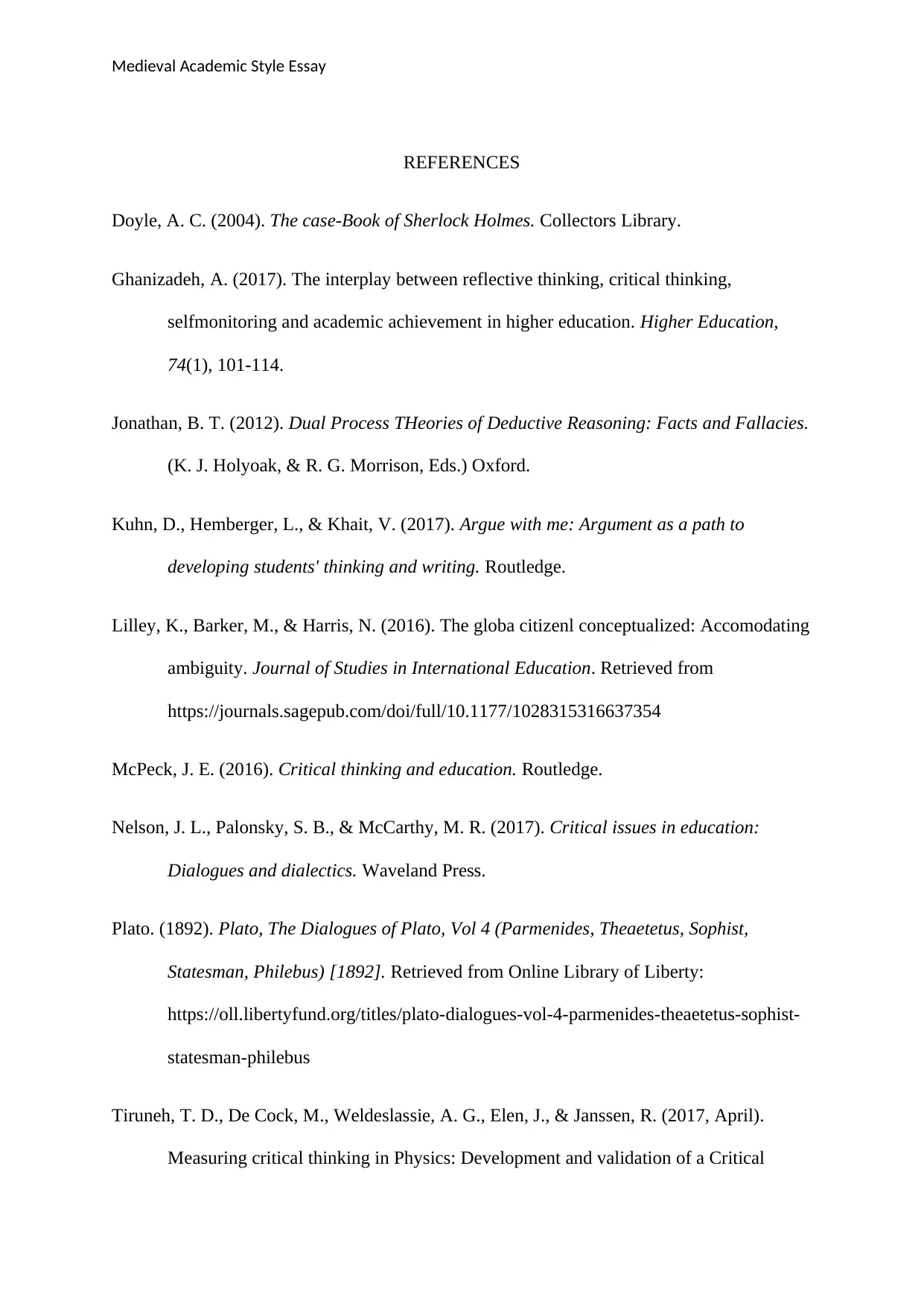
Medieval Academic Style Essay
REFERENCES
Doyle, A. C. (2004). The case-Book of Sherlock Holmes. Collectors Library.
Ghanizadeh, A. (2017). The interplay between reflective thinking, critical thinking,
selfmonitoring and academic achievement in higher education. Higher Education,
74(1), 101-114.
Jonathan, B. T. (2012). Dual Process THeories of Deductive Reasoning: Facts and Fallacies.
(K. J. Holyoak, & R. G. Morrison, Eds.) Oxford.
Kuhn, D., Hemberger, L., & Khait, V. (2017). Argue with me: Argument as a path to
developing students' thinking and writing. Routledge.
Lilley, K., Barker, M., & Harris, N. (2016). The globa citizenl conceptualized: Accomodating
ambiguity. Journal of Studies in International Education. Retrieved from
https://journals.sagepub.com/doi/full/10.1177/1028315316637354
McPeck, J. E. (2016). Critical thinking and education. Routledge.
Nelson, J. L., Palonsky, S. B., & McCarthy, M. R. (2017). Critical issues in education:
Dialogues and dialectics. Waveland Press.
Plato. (1892). Plato, The Dialogues of Plato, Vol 4 (Parmenides, Theaetetus, Sophist,
Statesman, Philebus) [1892]. Retrieved from Online Library of Liberty:
https://oll.libertyfund.org/titles/plato-dialogues-vol-4-parmenides-theaetetus-sophist-
statesman-philebus
Tiruneh, T. D., De Cock, M., Weldeslassie, A. G., Elen, J., & Janssen, R. (2017, April).
Measuring critical thinking in Physics: Development and validation of a Critical
REFERENCES
Doyle, A. C. (2004). The case-Book of Sherlock Holmes. Collectors Library.
Ghanizadeh, A. (2017). The interplay between reflective thinking, critical thinking,
selfmonitoring and academic achievement in higher education. Higher Education,
74(1), 101-114.
Jonathan, B. T. (2012). Dual Process THeories of Deductive Reasoning: Facts and Fallacies.
(K. J. Holyoak, & R. G. Morrison, Eds.) Oxford.
Kuhn, D., Hemberger, L., & Khait, V. (2017). Argue with me: Argument as a path to
developing students' thinking and writing. Routledge.
Lilley, K., Barker, M., & Harris, N. (2016). The globa citizenl conceptualized: Accomodating
ambiguity. Journal of Studies in International Education. Retrieved from
https://journals.sagepub.com/doi/full/10.1177/1028315316637354
McPeck, J. E. (2016). Critical thinking and education. Routledge.
Nelson, J. L., Palonsky, S. B., & McCarthy, M. R. (2017). Critical issues in education:
Dialogues and dialectics. Waveland Press.
Plato. (1892). Plato, The Dialogues of Plato, Vol 4 (Parmenides, Theaetetus, Sophist,
Statesman, Philebus) [1892]. Retrieved from Online Library of Liberty:
https://oll.libertyfund.org/titles/plato-dialogues-vol-4-parmenides-theaetetus-sophist-
statesman-philebus
Tiruneh, T. D., De Cock, M., Weldeslassie, A. G., Elen, J., & Janssen, R. (2017, April).
Measuring critical thinking in Physics: Development and validation of a Critical
Paraphrase This Document
Need a fresh take? Get an instant paraphrase of this document with our AI Paraphraser
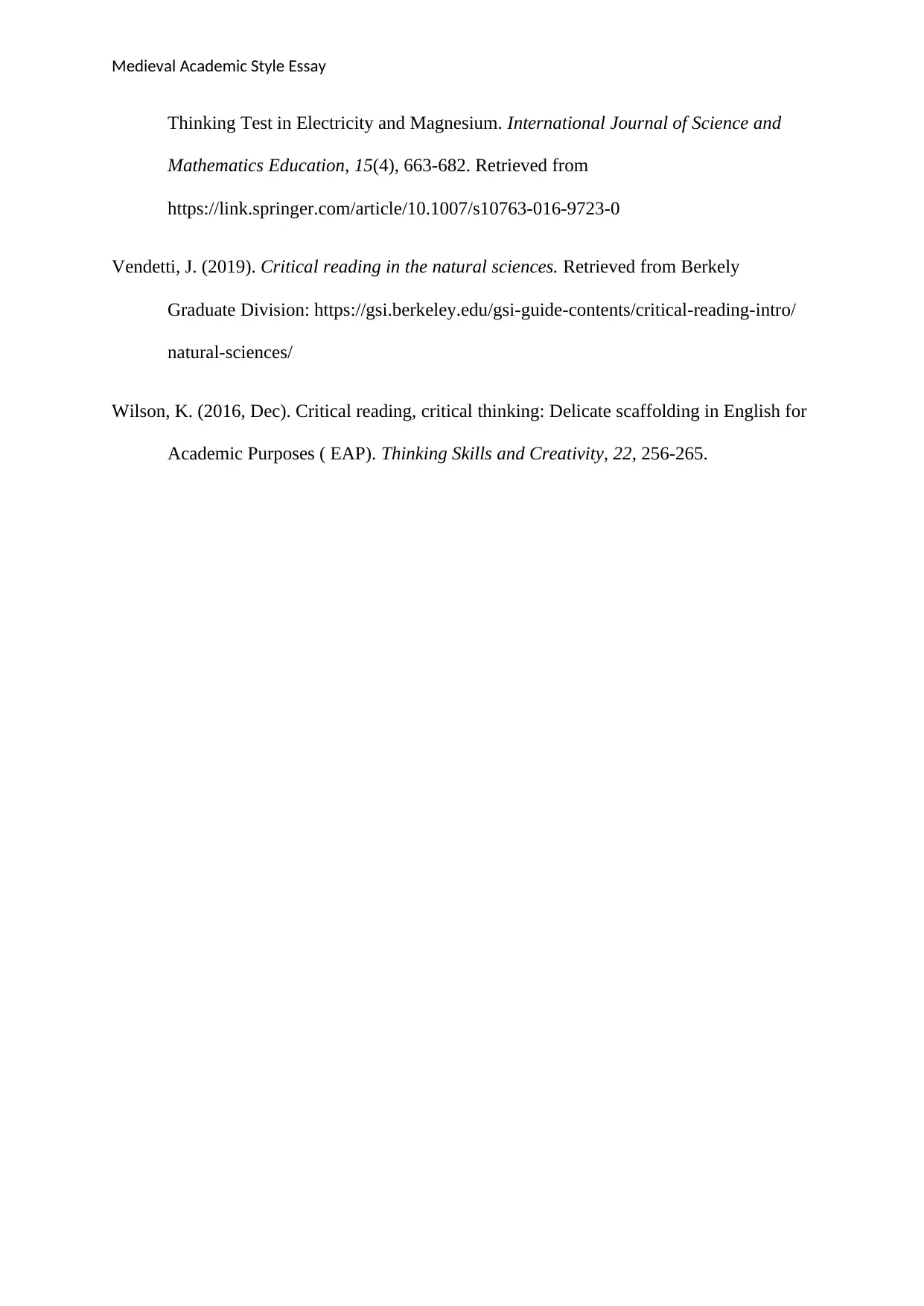
Medieval Academic Style Essay
Thinking Test in Electricity and Magnesium. International Journal of Science and
Mathematics Education, 15(4), 663-682. Retrieved from
https://link.springer.com/article/10.1007/s10763-016-9723-0
Vendetti, J. (2019). Critical reading in the natural sciences. Retrieved from Berkely
Graduate Division: https://gsi.berkeley.edu/gsi-guide-contents/critical-reading-intro/
natural-sciences/
Wilson, K. (2016, Dec). Critical reading, critical thinking: Delicate scaffolding in English for
Academic Purposes ( EAP). Thinking Skills and Creativity, 22, 256-265.
Thinking Test in Electricity and Magnesium. International Journal of Science and
Mathematics Education, 15(4), 663-682. Retrieved from
https://link.springer.com/article/10.1007/s10763-016-9723-0
Vendetti, J. (2019). Critical reading in the natural sciences. Retrieved from Berkely
Graduate Division: https://gsi.berkeley.edu/gsi-guide-contents/critical-reading-intro/
natural-sciences/
Wilson, K. (2016, Dec). Critical reading, critical thinking: Delicate scaffolding in English for
Academic Purposes ( EAP). Thinking Skills and Creativity, 22, 256-265.
1 out of 8
Your All-in-One AI-Powered Toolkit for Academic Success.
+13062052269
info@desklib.com
Available 24*7 on WhatsApp / Email
![[object Object]](/_next/static/media/star-bottom.7253800d.svg)
Unlock your academic potential
Copyright © 2020–2025 A2Z Services. All Rights Reserved. Developed and managed by ZUCOL.


